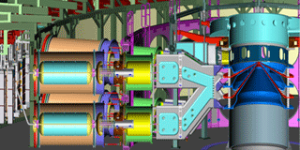
Sandia’s Z machine is Earth’s most powerful pulsed-power facility and X-ray generator.
Z compresses energy in time and space to achieve extreme powers and intensities, found nowhere else on Earth. In approximately 200 shots Z fires every year, the machine uses currents of about 26 million amps to reach peak X-ray emissions of 350 terawatts and an X-ray output of 2.7 megajoules.
The Z machine is located in Albuquerque, N.M., and is part of Sandia’s Pulsed Power Program, which began in the 1960s. Pulsed power is a technology that concentrates electrical energy and turns it into short pulses of enormous power, which are then used to generate X-rays and gamma rays. Produced in the laboratory, this controlled radiation creates conditions similar to those caused by the detonation of nuclear weapons, which is why from its earliest days pulsed power has been used to study weapons effects.
Weapons Research
Pulsed power has been explored for decades—with relatively small machines at first, and now in some cases more than three times the area of a tennis court, called accelerators. As accelerators were being developed for use in weapons research, a different kind of technology, the laser, was also being perfected and used for similar purposes.
Fusion Research & Lasers
For many years lasers were seen as the frontrunner technology for fusion research. Fusion — the process by which two atomic nuclei are joined together — is a powerful reaction currently being explored as a potential source of energy.
Lasers are useful in fusion research because of their great ability to focus tightly on a small area. This is crucial to fusion experiments because in order to compress and heat the starting materials enough to fuse atoms, power must be concentrated sharply on the target.
Compared to laser beams, the particle beams produced by early accelerators were difficult to focus to a small area. But during the 1980s Sandia developed complex accelerators designed specifically to study controlled fusion, and within the Pulsed Power Program, simulation of weapons effects started to contend with fusion in importance.
Z Pinch
One of Sandia’s accelerators started making big progress in the realm of fusion, not with particle beams, but with another technology known as the Z pinch. The Z pinch had been studied at Sandia since the 1960s as part of the weapons program, but its potential for fusion was not explored because particle beams seemed better suited for that purpose.
With the Z pinch revelation, Sandia moved the focus of its fusion research away from particle beams, and in 1997 it reconfigured one of its accelerators to explore the potential of Z pinches instead. Accelerators, in particular the one that came to be known as the “Z machine,” suddenly became an unexpected and very strong candidate in the fusion arena.
For the past decade, images of the spectacular Z machine in action have garnered as much attention in the popular press as its scientific breakthroughs have among researchers. Today the facility continues to be a major tool in the development of Sandia’s weapons effects, weapons physics, and fusion technologies, all of which make invaluable contributions to science, national security, and fusion energy research.
Z machine’s purpose:
Discovery science on the behavior of matter at extreme conditions, contributing to:
- A fundamental understanding of nature: most of the universe’s matter is under the extreme conditions that we study with Z; the conditions we’re used to here on Earth are actually quite rare in the universe
- Fusion research in the laboratory: researchers conduct fusion experiments all the time with Z, but they’re trying to optimize the energy output for useful applications, such as energy generation
- A greater understanding of the safety, security, and reliability of our nation’s nuclear weapons stockpile
